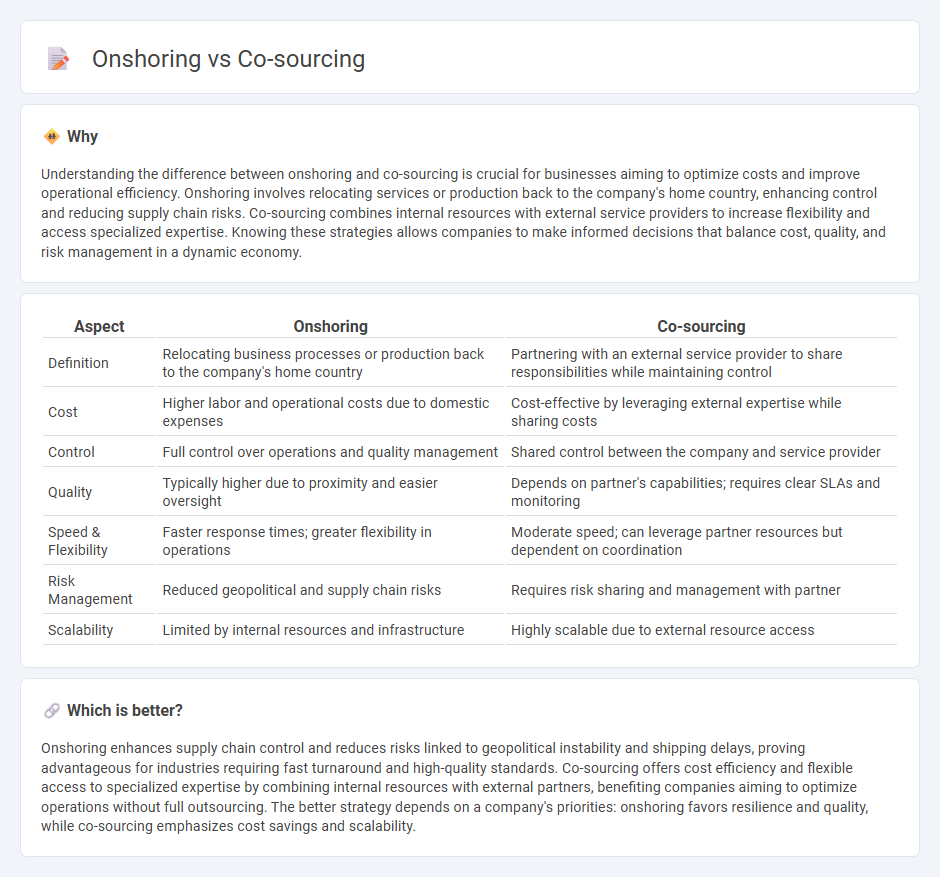
Onshoring involves relocating business operations or manufacturing back to the company's home country, boosting local employment and reducing supply chain risks. Co-sourcing blends internal resources with external expertise, optimizing cost-efficiency and innovation without full outsourcing. Explore the strategic advantages and economic impacts of onshoring versus co-sourcing to enhance your business decisions.
Why it is important
Understanding the difference between onshoring and co-sourcing is crucial for businesses aiming to optimize costs and improve operational efficiency. Onshoring involves relocating services or production back to the company's home country, enhancing control and reducing supply chain risks. Co-sourcing combines internal resources with external service providers to increase flexibility and access specialized expertise. Knowing these strategies allows companies to make informed decisions that balance cost, quality, and risk management in a dynamic economy.
Comparison Table
| Aspect | Onshoring | Co-sourcing |
|---|---|---|
| Definition | Relocating business processes or production back to the company's home country | Partnering with an external service provider to share responsibilities while maintaining control |
| Cost | Higher labor and operational costs due to domestic expenses | Cost-effective by leveraging external expertise while sharing costs |
| Control | Full control over operations and quality management | Shared control between the company and service provider |
| Quality | Typically higher due to proximity and easier oversight | Depends on partner's capabilities; requires clear SLAs and monitoring |
| Speed & Flexibility | Faster response times; greater flexibility in operations | Moderate speed; can leverage partner resources but dependent on coordination |
| Risk Management | Reduced geopolitical and supply chain risks | Requires risk sharing and management with partner |
| Scalability | Limited by internal resources and infrastructure | Highly scalable due to external resource access |
Which is better?
Onshoring enhances supply chain control and reduces risks linked to geopolitical instability and shipping delays, proving advantageous for industries requiring fast turnaround and high-quality standards. Co-sourcing offers cost efficiency and flexible access to specialized expertise by combining internal resources with external partners, benefiting companies aiming to optimize operations without full outsourcing. The better strategy depends on a company's priorities: onshoring favors resilience and quality, while co-sourcing emphasizes cost savings and scalability.
Connection
Onshoring and co-sourcing are interconnected strategies that enhance operational efficiency and reduce costs by relocating business processes closer to the home country while sharing responsibilities with external partners. Onshoring ensures greater control and improved supply chain resilience by localizing production, while co-sourcing combines internal resources with specialized external expertise to optimize service delivery. Together, these approaches support economic growth through job creation, innovation, and strengthened domestic industries.
Key Terms
Resource Allocation
Co-sourcing enables companies to pool internal and external resources efficiently, leveraging specialized expertise without fully outsourcing operations. Onshoring centralizes resource allocation domestically, reducing communication barriers and enhancing control over project workflows while maintaining proximity to core teams. Explore the benefits and challenges of co-sourcing versus onshoring to optimize your resource allocation strategy.
Labor Cost
Labor costs in co-sourcing arrangements often provide flexibility by combining internal staff with external experts, reducing overall expenses compared to full in-house teams. Onshoring typically involves higher wages due to domestic labor market standards but offers benefits of proximity and cultural alignment that can enhance communication and project control. Explore the detailed cost-benefit analysis of co-sourcing versus onshoring to optimize your workforce strategy.
Operational Control
Co-sourcing enhances operational control by allowing companies to collaborate directly with external partners while retaining key management decisions and processes in-house. Onshoring consolidates operational control within domestic boundaries, facilitating faster communication, compliance, and quality oversight. Explore further to understand which strategy best aligns with your organizational goals for operational efficiency.
Source and External Links
What is co-sourcing? - OneSource Virtual - Co-sourcing combines internal and external resources to achieve business goals, integrating external experts as part of the in-house team for ongoing collaboration.
Co-Sourcing is the New Outsourcing | Innovative Talent Solutions - Co-sourcing is a shared, collaborative delivery of process capabilities with third-party providers, enabling companies to build more sophisticated and specialized operations without losing institutional knowledge.
A Definitive Guide to Co-Sourcing | 4Pines Fund Services LLC - In co-sourcing, the client retains control of their data and software, while the service provider works directly within the client's system to perform specialized tasks, enhancing transparency and collaboration.
 dowidth.com
dowidth.com